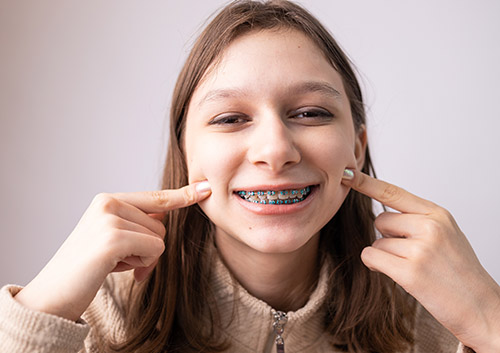Protect Your Baby from Early Childhood Caries
October 17th, 2025

Your baby’s first smiles are precious—and you want to make sure those precious smiles are as healthy as they are beautiful. One of the most important ways to protect your child’s dental health is by preventing early childhood caries, or cavities.
You might be thinking, “Tooth decay? Babies?” Yes, babies and toddlers can get cavities, too. Studies suggest that over a quarter of children between the ages of two and five already have some form of tooth decay.
The bacteria that cause tooth decay are passed from person to person. Cavity-causing bacteria use the sugar and starches in our diets to produce acids—acids which attack the tooth’s enamel, breaking down its hard mineral structure until cavities form. Because baby teeth have thinner enamel coatings than adult teeth, they are especially vulnerable to tooth decay.
You can start your child on the path to a lifetime of healthy smiles by being proactive about cavity prevention during your baby’s first 12 months.
- Don’t Share Bacteria
Because cavity-causing oral bacteria are transmitted from person to person, doctors and dentists suggest that you don’t share a spoon with your baby, or put a pacifier in your mouth to clean it. And it’s a good idea to rinse toys used by other children with clean water before giving them to your child.
- Keep Bottles Out of Bed
Babies generally need a feeding before bedtime to ensure that they get all the nutrition their growing bodies need. But when a young child sleeps with a bottle, liquids pool in the mouth, exposing tiny teeth to these liquids throughout the night and preventing the natural flow of saliva from washing food particles away.
Bring your child’s happy day to a close with a lullaby, a bedtime story, a good night kiss, or whatever makes your baby feel comforted and loved—and take the bottle with you when you tiptoe out of the room.
- Avoid Sugary Drinks
How do parents make sure their babies get the nutrition they need without giving cavity-causing bacteria the fuel they need? With a healthy diet. Breast milk and formula have healthy nutrients, carbs, and sugars which are necessary for baby’s growth and development. Sugar water, sweet juices, and sodas—don’t.
Added sugars provide a feast for cavity-causing bacteria, and the more your child is exposed to them throughout the day, the greater the risk of tooth decay. Talk to Drs. Angela Paros, Amer Atassi, Eric Young, Alexander Katsnelson for the healthiest drinks for your baby’s bottle or sippy cup.
- Clean Baby’s Teeth and Gums
Dentists recommend cleaning your baby’s gums even before teeth begin to arrive. After washing your hands, using a clean, damp, soft cloth or gauze pad to gently wipe the gum surfaces to remove bacteria and food.
As soon as the first tooth appears, it’s time to start gentle brushing. Use a baby-sized toothbrush to gently clean the erupting teeth once in the morning and once after the last feeding of the day. And as soon as two baby teeth touch, it’s time to talk about flossing.
Not sure about baby-friendly tooth care products, toothpastes, and techniques? Talk to Drs. Angela Paros, Amer Atassi, Eric Young, Alexander Katsnelson! Learn about cleaning little gums, baby-size brushes, when to begin using fluoride toothpaste and how much toothpaste to use, when to brush, and when to start flossing.
- Establish a Dental Home for Your Child
The ideal time for your child’s first visit to our Romeoville, IL office is sometime between the appearance of your child’s first tooth and your child’s first birthday. It’s a gentle way to introduce your baby to the dental team who will be caring for those little smiles for many years to come.
During that first visit, your child’s dentist will check tooth and jaw development. There will be a child-friendly examination to look for plaque buildup or any signs of early decay, such as white spots on tooth enamel. You can talk about any concerns you might have and learn the best ways to prevent tooth decay with proactive dental care for healthy teeth and gums.
Why are we so concerned about baby teeth? Decayed teeth can cause pain and self-consciousness. And more, those tiny teeth have big responsibilities. Baby teeth influence your child’s speech development. They promote healthy eating and chewing habits. Baby teeth serve as placeholders to make sure that your child’s adult teeth will be able to erupt just where they should.
Your baby’s first smiles are precious. And when you’re proactive with early dental care, you’re preparing your child for a lifetime of healthy smiles.
When Extraction Is Your Best Option
October 17th, 2025

Dentists use advanced procedures to save teeth which would have been lost a few decades ago. But sometimes, when a tooth is severely compromised, it just can’t be saved. In this case, extraction is the best and healthiest option.
When might Drs. Angela Paros, Amer Atassi, Eric Young, Alexander Katsnelson recommend an extraction? Conditions which call for extraction could include:
- Severe Gum Disease
The CDC estimates that almost 50% of those aged 30 and older suffer from some form of gum disease, with the number rising to over 70% of adults aged 65 and older. Serious gum disease, or periodontitis, is the leading cause of tooth loss in adults.
Periodontitis can cause the gums to pull away from the teeth, creating pockets where bacteria multiply and infection develops. Left untreated, infection destroys the connective tissue and bone which hold the teeth in place. Teeth become loose and eventually fall out. When tooth loss is inevitable, extraction can be a healthier option than waiting for the tooth to fall out.
- Serious Infection
When infection reaches the pulp inside the tooth, immediate treatment is necessary. An infected tooth will never get better on its own, and the infection can spread from the tooth to the surrounding gums and bone, creating a pus-filled abscess. When caught early enough, a root canal procedure can save your tooth. If root canal treatment isn’t possible or infection keeps recurring, extraction can be the best option to prevent infection from spreading and destroying gum and bone tissue.
- Wisdom Teeth
When wisdom teeth have no room to erupt, they may become completely impacted, lodged in the bone and gum tissue. Or they may begin to break through the gums but aren’t able to erupt completely (partial impaction), making them difficult to clean and vulnerable to infection and decay. When wisdom teeth begin to erupt without sufficient space, they can move horizontally or diagonally, putting destructive pressure on the roots of neighboring molars. Extracting wisdom teeth is a proactive measure for promoting long-term dental health.
- Extensive Cracks or Fractures
Caught early, cracks in the crown of a tooth or small fractures in a tooth root might be treated with root canal therapy or endodontic surgery. When a crack in the crown of the tooth extends below the gumline, or when a vertical fracture begins in the root of the tooth and spreads upward to the crown, the tooth often cannot be saved.
- Extensive Decay
When a tooth has experienced mild to moderate decay, your dentist can remove the decayed portion, clean the area, and restore the tooth with a filling or a crown. If the decay is too extensive, there won’t be sufficient healthy tooth structure left for a restoration, and extraction will be necessary.
- Trauma
Often a dislodged tooth can be restored to its place in the mouth when the injury is treated early enough and the damage is limited. When a tooth or its surrounding bone and ligaments are so badly damaged from trauma that the tooth can’t be reimplanted or restored with endodontic or surgical treatment, extraction is the healthiest choice.
When advanced gum disease or other conditions make extraction necessary, our team at High Point Dental Group will provide expert treatment to protect your oral health. Drs. Angela Paros, Amer Atassi, Eric Young, Alexander Katsnelson and our team have the specialized skill and experience needed to:
- gently extract the tooth
- treat and restore surrounding gum and bone tissue as needed
- provide you with sedation options before the procedure
- provide options for pain management after the procedure
- give you detailed instructions for aftercare
- suggest follow-up options such as tooth implants, which can restore your smile with a replacement which looks and functions like a natural tooth
Extraction is never your first choice, or your periodontist’s! Proactive tooth and gum care help save teeth for a lifetime. But when an extraction is necessary for your oral health, everyone at High Point Dental Group in Romeoville, IL will ensure that you receive expert professional care.
October Is Orthodontic Health Month!
October 16th, 2025

October’s here! A month when we celebrate the beauty of fall, the taste of pumpkin spice, the fun of Halloween in Romeoville, IL, and the healthy smiles which orthodontic treatment makes possible!
Because October is Orthodontic Health Month, and it’s a great time to talk about how your orthodontist helps you create not just a more beautiful smile, but a healthier one.
Straight, evenly spaced teeth are the visible benefit of treatment, but there are many health benefits which might not be quite as noticeable. Orthodontic treatment can:
- Help You Prevent Cavities and Gum Disease
When teeth are crowded or crooked, it’s hard for your toothbrush and floss to reach all of the plaque which builds up on and between your teeth. The bacteria in plaque create acids which start to dissolve tooth enamel. And a very small hole in the enamel surface can grow until it becomes a cavity.
Plaque and bacteria also irritate the gums. When you can’t remove plaque completely, your gums are at risk for gingivitis. This early stage of gum disease causes redness, tenderness, swelling, and bleeding. Left untreated, gingivitis can develop into more serious gum disease.
And, over time, plaque hardens and becomes tartar, which needs to be removed professionally at High Point Dental Group.
When your teeth are straight and evenly spaced, brushing and flossing are both easier and more effective, helping you keep your teeth and gums healthy and plaque-free.
- Create a Better Bite
For a healthy bite, your teeth and jaws need to align correctly. The top teeth should slightly overlap the lower teeth, and the ridges of your upper molars should fit smoothly with the grooves of your lower molars.
Malocclusions, or bad bites, can come in many forms, including overbites, underbites, open bites, cross bites, and overjets. A bad bite is bad for your dental health. Malocclusions can cause tooth grinding, worn enamel, and even cracked teeth.
And bad bites don’t just affect your teeth. When your bite doesn’t align properly, you might suffer from problems such as headaches, jaw pain, indigestion, and sleep apnea.
Orthodontic treatment creates a healthy, symmetrical, and pain-free bite.
- Improve Your Self-Confidence
We can’t forget the invisible health benefits of orthodontic treatment! Your smile is a gift which you share with the world. But if you’re hesitating to smile because of self-consciousness about your teeth or bite, orthodontic treatment can make a world of difference.
Your orthodontist can help you achieve straighter teeth, a bite which fits together properly, and, when malocclusions affect jaw symmetry, a more balanced facial profile. If you’re concerned about the appearance of your smile, talk to Drs. Angela Paros, Amer Atassi, Eric Young, Alexander Katsnelson about an orthodontic consultation. Today’s technology can even let you see what your future smile will look like!
Modern orthodontic treatment is more effective and takes less time to complete than ever before. And orthodontics offers patients of all ages more benefits than ever before:
- New types of braces are less noticeable and more comfortable than older styles. Smaller brackets, brackets which blend with tooth enamel, clear aligners, and lingual braces give you a variety of options to customize your treatment.
- Early orthodontic treatment can guide jaw growth in younger children.
- Appliances can help with jaw alignment in older children, or, for more serious malocclusions, an orthodontist can coordinate treatment with an oral surgeon.
- Treatment isn’t limited to the teen years. Adults make up a large and growing number of orthodontic patients.
If you’ve been considering orthodontic treatment, October—or any month!—is a great time to schedule a visit with an orthodontist. An orthodontic evaluation will let you know just what your orthodontist can do to help you create a beautiful and healthy smile.
Dental Visits Are Not So Bad
September 24th, 2025

Many people dread going to the dentist. Dental visits have the reputation of being painful and uncomfortable, and it is common for people to compare unfortunate situations such as having a root canal or feeling the dentist’s drill. However, at High Point Dental Group, dental visits are not that bad.
Your regular cleaning and checkup are noninvasive. They require no drilling, Novocain, or needles, and you go home with refreshingly clean teeth. When your hygienist cleans your teeth, you are literally receiving individualized care from a professional as you sit back and relax.
In the days before the use of Novocain or other anesthetics, dental work could be painful. Thankfully, those days are gone! Now you are unlikely to feel a thing, even during the most extensive procedures. In addition, most dental work such as fillings, root canals, and crowns can be performed in one to two visits, so you do not need to keep returning to High Point Dental Group.
An incentive for getting over your fear and coming to the dentist is that getting your dental work done can dramatically improve your quality of life. Drs. Angela Paros, Amer Atassi, Eric Young, Alexander Katsnelson can address tooth problems that have caused toothaches or prevented you from eating the foods you like. As a bonus, regular visits with Drs. Angela Paros, Amer Atassi, Eric Young, Alexander Katsnelson and our staff allow us to identify conditions such as periodontal disease, which can indicate risk for seemingly unrelated health conditions, such as heart disease and diabetes.






